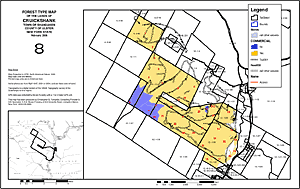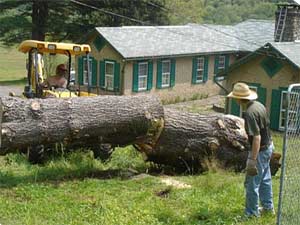Environmentally Responsible and Sustainable Land Management
Serving Southern New York State and Western Connecticut.
Lands of Robert F. Cruickshank
Lands of Michelotti >Introduction

The Cruickshank case study property has been owned by the family since 1879, when it was purchased by James Cruickshank; soon after arrival from Scotland. The family did not prepare for the potentially difficult estate settlement of Helen Cruickshank, which lasted 25 years between the three indivisible interest holding heirs. The estate was purchased outright by my father and brother, in a valiant effort to save the contiguous nature of the property and to pass on a 127 year legacy.
Challenge
The property is a 1,200 acre holding in the central Catskill Mountains of New York State. The tax and loan financial liability on the property could not be sustained under current circumstances and conventional methods. The income producing potential of the family and timber could not meet these financial obligations in perpetuity. Further, the new owner needed a retirement income for himself and his wife. In addition, he did not want to transfer any financial hardship to his children during or after the settlement of his own personal estate. The obvious strategy would have been to sell parcels for top dollar to timber buyers and developers, compromising years of family forestland tutelage and the family name. The result of this agreement left the new owner in a financial and preservation quagmire. How was he going to achieve his conservation and estate planning goals while satisfying his monetary burden?
Resolution
The family assembled a team; consisting of siblings, private, non-profit and public entities to answer this question. With the Open Space Institute coordinating proceedings; The Nature Conservancy and the New York State Department of Environmental Preservation pulled together to set historic precedence in estate and conservation planning implementation.

James Cruickshank, founder and owner of Legacy Property Management, served as a consult and researcher on this complex project. Cruickshank summarized and corroborated owner Goals, Values and Objectives to protect the family interest and sharpen focus. Cruickshank supplied various conflict resolution methods to extract, prioritize and address all important issues that related to the property and sustainability. Cruickshank established sound methodology to be applied to all phases of forestry work on the project including: cruise, inventory, silviculture, timber harvest, road improvements, erosion control, cartographic products and the reports depicting the same. In addition, Cruickshank provided viable and ethical options to benefit the management, income and preservation of the resource. The results of this planning lead to a sustainable and environmentally responsible model; that satisfied the owner’s long term goals for the property while benefiting the local land conservation effort and economy in perpetuity.
Although some land had to be sold, The Nature Conservancy was engaged and worked to preserve areas of distinction. These parcels were later deeded to the New York State Department of Environmental Preservation, as a means to protect them in perpetuity.
The remaining property was entered into New York State 480a tax code and a 50% value conservation easement, reducing the financial burden of the holding to a level that is sustainable. In the end, all the owner goals were realized and the family name and property will be protected on a sustainable basis, for generations to come.
LPM and the Cruickshank family would like to thank the following participants who made this wonderful outcome possible:
Chris Tcimpidis, Bevan Forestry
Alan White, Catskill Land Association and The Nature Conservancy
Mark King, The Nature Conservancy
Jim Waters, Catskill Forest Association
Jennifer Grossman, Open Space Institute
Dave Tobias, NYS Department of Environmental Preservation